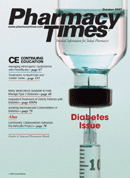Secondary Smoke Is Dangerous to Asthmatic Children
Ms. Norwalt is a 2008 PharmD candidate and Dr. Isaac is a clinical assistant professor of pharmacy at Xavier University of Louisiana College of Pharmacy, New Orleans.
Smoke that is produced by cigars or cigarettes is known as secondary smoke or environmental tobacco smoke (ETS). This smoke contains chemicals that are harmful to the human body, such as hydrogen cyanide, benzene, and formaldehyde. These products are carcinogenic and toxic, causing increased risk for lung cancer, asthma, respiratory infections, and some types of heart disease. Secondary smoke exposure has been noted to worsen asthma symptoms in 400,000 to 1 million asthmatic children.1
Approximately 35% of children in America live with caregivers who smoke or have visitors who smoke in the home regularly.2It is necessary to educate parents about the dangers of secondary smoke on asthmatic children. Members of the health care community can play a pivotal role in providing this information.
Physiologic Changes
When tobacco smoke is inhaled, physiologic changes occur in the lungs. The cilia, tiny hairs in the lungs, are a natural defense against foreign objects entering deep into the bronchial tree. These cilia push particles upward, moving them out of the lungs, and then they often are swallowed. When the toxins in secondary smoke are introduced into the lungs, cilia function decreases, along with the number of cilia produced. The cleaning process is hindered, leaving the lungs more susceptible to infection.
Mucus production is increased with exposure to cigarette smoke because of the increased number of mucus cells and their cell size. Excessive mucus trapped in the lungs causes infection, cough, and narrowed airways.
The carcinogenic chemicals in secondary smoke cause the cells in the lungs to change composition, making cancer occurrence more likely. Some common effects due to ETS are cough, shortness of breath, wheezing, lung infections, and increased symptoms of asthma.3
Studies
Retrospective studies have analyzed the effects of secondary smoke in children. To find a correlation between secondary smoke and asthma exacerbations, one study analyzed 954 children who presented to the emergency department with acute asthma. Approximately 36% of the caregivers reported that their child was exposed to ETS. Of this subgroup, 65% were exposed daily. Asthmatic children exposed to ETS were significantly more likely to be girls, to come from a lower-income family, to have pets at home, and to use their controller medications less. There was a weak association between the severity of the asthma attack and the exposure to secondary smoke.4
Other studies have been conducted to determine the effects of smoking bans and education on the caregivers of asthmatic children. Smoking bans are defined as prohibitions on smoking in certain environments, such as homes, vehicles, restaurants, or workplaces.5 One study found that children living with smokers were 10 times less likely to have smoking bans in place. Most health care professionals (82%) counseled patients about smoking bans in the home environment, but 60% forgot to ask about smoking in a vehicle. The study concluded that a significant portion of asthmatic children are not being protected by smoking bans in their own homes, and so it is necessary to educate parents about smoking bans and cessation.6
In another study, parents of asthmatic children were educated twice a week about secondary smoke and were instructed to limit the amount of ETS exposure to their child. The result was a 40% to 80% reduction of exposure to ETS, when compared with baseline exposure. The study also showed during later follow-ups that parents continued these precautions.7
Patient Counseling
It is imperative to try to decrease the amount of ETS to which asthmatic children are exposed. The American Lung Association recommends that cigarette smoke should be avoided in the homes of asthma patients, especially children. Children's asthma condition has been shown to improve when the parents decline from smoking in their environment.8
As pharmacists, it may seem difficult to talk to parents or caregivers about this issue. The Table provides helpful tips for pharmacists on counseling parents on secondary smoke in order to benefit asthmatic children. With physicians, pharmacists, nurses, and other health care providers working together to educate the community on the dangers of secondary smoke to children, a tremendous impact can be made on the number of children exposed to ETS.
References
1. American Lung Association. Asthma and Children Fact Sheet. Available at: www.lungusa.org. Accessed August 29, 2007. 2. American Lung Association. Secondhand Smoke Fact Sheet. Available at: www.lungusa.org. Accessed August 29, 2007. 3. University of Pittsburgh Medical Center. Patient Education Materials: Smoking and Your Lungs. Available at: http://patienteducation.upmc.com. Accessed August 29, 2007.
4. Vargas PA, Brenner B, Clark S, Boudreaux ED, Camargo CA Jr. Exposure to environmental tobacco smoke among children presenting to the emergency department with acute asthma: a multicenter study. Pediatr Pulmonol. 2007;42:646-655.
5. Wikipedia contributors. Smoking ban. Wikipedia, The Free Encyclopedia. Available at: http://en.wikipedia.org/wiki/Smoking_bans. Accessed September 19, 2007.
6. Halterman JS, Fagnano M, Conn KM, Szilagyi PG. Do parents of urban children with persistent asthma ban smoking in their homes and cars? Ambul Pediatr. 2006;6:115-118.
7. Meltzer SB, Hovell MF, Meltzer EO, Atkins CJ, de Peyster A. Reduction of secondary smoke exposure in asthmatic children: parent counseling. J Asthma. 1993;30:391-400.
8. Schuster MA, Franke T, Pham CB. Smoking patterns of household members and visitors in homes with children in the United States. Arch Pediatr Adolesc Med. 2002;156:1094-1100.
9. Polanska K, Hanke W, Ronchetti R, et all. Environmental tobacco smoke exposure and children's health. Acta Paediatr Suppl. 2006;95:86-92.

